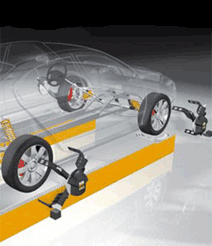 Wheel
alignment or tracking refers to the procedure of lining up the
components of your steering including the camber, caster and toe. Wheels
that are not aligned properly can wear out your tyres a lot quicker and
along with steering and handling issues it can also damage the
suspension system of your car.
Wheel
alignment or tracking refers to the procedure of lining up the
components of your steering including the camber, caster and toe. Wheels
that are not aligned properly can wear out your tyres a lot quicker and
along with steering and handling issues it can also damage the
suspension system of your car.
Possible warning signs or indications showing that your
vehicles wheel alignment is out include a constant steering pull to one
side, a squeaky tyre noise when making turns, possible vibrations the
faster you travel and a instant change in direction where the car just
drags to the other side when you hit a bump on the road. Other signs
incude looking at the tyre for uneven wear especially on the inside
shoulder or outisde, if your tyres are wearing down excessively on the
inside or ousside on both tyres then this is could be down to the
allignment out. If youre vehcile is steering on one side you should
also look for other signs including tyre wear in most cases there are
other issues including uneven tyre pressure or even tyre wear which can
cause the vehicle to steer one side.
Nowadays wheel alignment has become computerised,
there used to be the good old-fashioned guess way once upon a time, we
then moved on to lasers ad now as cars have become more complex and
modern we have computerised wheel aligment. The computerised wheel
alignment allows you to measure all the angles that are adjustable and
non adjustable, the angles that can’t be adjusted would need to be
repaired or replaced with new parts. The angles that can be adjusted are
most likely to be the toe, camber, caster and thrust angle.
There are some motorists who confuse the wheel alignment with wheel balancing. The alighment is not done as part of the service offeried when changing a tyre. Wheel alignment done on a vehicle lift this usualy requies a booking with most garages and depending on the centre their own charges.